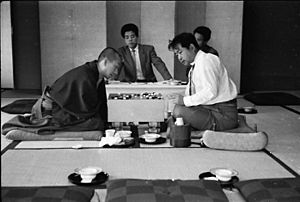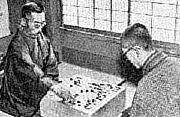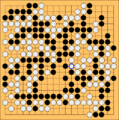Go Seigen facts for kids
Quick facts for kids Go Seigen |
|
|---|---|

Go Seigen in 1952
|
|
| Full name | Go Seigen |
| Pinyin | Wú Qīngyuán |
| Born | June 12, 1914 Minhou County, Fujian, Republic of China |
| Died | November 30, 2014 (aged 100) Odawara, Kanagawa Prefecture, Japan |
| Residence | Tokyo, Japan |
| Teacher | Segoe Kensaku (from 1928) |
| Pupil | Rin Kaiho |
| Turned pro | 1929 (given 3 dan) |
| Retired | 1983 |
| Rank | 9 dan |
| Affiliation | Nihon Ki-in |
| Go Seigen | |||||||||||||||||
|---|---|---|---|---|---|---|---|---|---|---|---|---|---|---|---|---|---|
| Chinese name | |||||||||||||||||
| Traditional Chinese | 吳清源 | ||||||||||||||||
|
|||||||||||||||||
| Japanese name | |||||||||||||||||
| Kanji | 呉 清源 | ||||||||||||||||
| Kana | ご せいげん | ||||||||||||||||
|
|||||||||||||||||
| Wu Quan | |||||||||||||||||
|---|---|---|---|---|---|---|---|---|---|---|---|---|---|---|---|---|---|
| Chinese name | |||||||||||||||||
| Traditional Chinese | 吳泉 | ||||||||||||||||
|
|||||||||||||||||
| Japanese name | |||||||||||||||||
| Kanji | 呉 泉 | ||||||||||||||||
| Kana | ご せん/くれ いずみ | ||||||||||||||||
|
|||||||||||||||||
Wu Quan (Chinese: 吳泉), also known by his courtesy name Wu Qingyuan (Chinese: 吳清源) (June 12, 1914 – November 30, 2014), was a famous Go player. He was born in China but became well-known by the Japanese pronunciation of his courtesy name, Go Seigen (ご せいげん). Many people believe he was the greatest Go player of the 20th century.
Contents
His Life Story
Go Seigen was born on June 12, 1914, in Minhou County, Fujian Province, in southeast China. He started learning Go when he was nine years old. This was a bit late for a professional player, as many start much younger. His father, who had learned Go in Japan, taught him the game.
Go Seigen quickly became very good and was known as a Go child prodigy. By age 12, less than three years after starting, he was already playing like a professional. This was clear from his games against a Japanese player named Iwamoto Kaoru in 1926.
The next year, he tied a two-game match against another Japanese professional, Inoue Kohei. In 1928, at just 14 years old, he beat Utaro Hashimoto twice. Go Seigen's amazing skill became known in Japan, which was the leading country for Go at the time. Important people invited him to Japan. He moved there in 1928 and started his professional career. His teacher was Segoe Kensaku.
Go Seigen quickly rose to the top of the Go world. By the time he was 18, he was already one of the best players. In 1933, with his good friend Kitani Minoru, Go Seigen created a new way to start Go games called the Shinfuseki. This changed how people played the opening of the game. Because of this important idea, Go Seigen and Kitani are seen as the founders of modern Go.
Starting in 1939, Go Seigen played many special matches called Jubango against other top players. These matches showed how much better he was than everyone else. Go Seigen had two main students: Rin Kaiho and Rui Naiwei, who became a very strong female Go player.
Later Years and Passing
In the summer of 1961, Go Seigen was hit by a motorcycle. He had to stay in the hospital for two months and then again for a longer time a year later. He suffered nerve damage, which made it hard for him to play long games. He would feel sick and dizzy. This accident marked the end of his top playing career. He played less and less often and mostly retired in 1964, though he didn't officially retire until 1983.
After retiring, Go Seigen stayed active in the Go community. He taught, wrote books, and helped promote the game around the world. Some of his books include A Way of Play for the 21st Century and Modern Joseki Application Dictionary. He also held study sessions with other professional players.
In 1987, Go Seigen received a very high award from Japan, the Grand Cordon of the Order of the Rising Sun. This was for all his contributions to Go throughout his life.
In 1999, Go Seigen's manager said that Go Seigen was one of only three Go players who would still be remembered hundreds of years later. The other two were Honinbo Dosaku and Hon'inbō Shūsaku.
Go Seigen passed away peacefully on November 30, 2014, at a hospital in Odawara, Japan. He was 100 years old. He was buried in his hometown of Fuzhou, China, as he wished.
His Professional Record
Go Seigen is often thought to be one of the best Go players ever. Many call him the best player of the 20th century. He was the strongest player for more than 25 years. He had an amazing record in matches and beat all the top players of his time in a series of famous jubango (matches with ten games). He even made some of them play with a handicap (giving him an advantage). Some of the players he beat were Kitani Minoru, Karigane Junichi, Utaro Hashimoto, Iwamoto Kaoru, Fujisawa Hosai, Eio Sakata, and Kaku Takagawa.
Go Seigen only lost one jubango, and that was against Fujisawa Hosai. However, Fujisawa played with a handicap throughout that match, and still only won by a small amount (6 to 4). About ten years later, Go Seigen beat Fujisawa in two more jubango matches by large scores. These jubango matches were played without komi (extra points given to the second player in modern Go). Go Seigen won the Oteai tournament six times and a special championship in 1933.
Here is a table of Go Seigen's jubango matches:
| Opponent | Record | Dates played |
|---|---|---|
| Kitani Minoru 5p | 3 wins - 3 losses (match stopped when Kitani was promoted) | 1933–34 |
| Kitani Minoru 7p | 6 wins - 4 losses (Kitani had to play with a handicap after 6 games) | 1939–40 |
| Karigane Junichi 8p | 4 wins - 1 loss (match stopped to avoid Karigane having to play with a handicap) | 1941–42 |
| Fujisawa Kuranosuke 6p, later renamed Fujisawa Hosai | 4 wins - 6 losses (Fujisawa played with a handicap from the start) | 1942–44 |
| Utaro Hashimoto 8p | 6 wins - 3 losses - 1 draw (Hashimoto had to play with a handicap after 8 games) | 1946–48 |
| Iwamoto Kaoru 8p | 7 wins - 2 losses - 1 draw (Iwamoto had to play with a handicap after 6 games) | 1948–49 |
| Against a team of ten players | 8 wins - 1 loss - 1 draw (this was a 10-game match, but not a jubango) | 1949–50 |
| Hashimoto Utaro 8p | 5 wins - 3 losses - 2 draws (Hashimoto played with a handicap from the start) | 1950–51 |
| Fujisawa Hosai 9p | 7 wins - 2 losses - 1 draw (Fujisawa had to play with a handicap after 9 games) | 1951–52 |
| Fujisawa Hosai 9p | 5 wins - 1 loss (match stopped when Fujisawa had to play with a bigger handicap) | 1952–53 |
| Eio Sakata 8p | 6 wins - 2 losses (match stopped when Sakata had to play with a bigger handicap) | 1953–54 |
| Kaku Takagawa 8p | 6 wins - 4 losses (Takagawa had to play with a handicap after 8 games) | 1955–56 |
His Playing Style
Go Seigen was known for playing Go very quickly. He had a strong, fighting style. He was also very good at judging the board and reading moves ahead. He would quickly settle his groups of stones and move to important parts of the board first. He often used much less time than his opponents. He was excellent at using "thickness" (strong stone formations) and making big exchanges of territory. His reading of the game was fast and correct, and his ideas about where to play were often praised. He also rarely lost a "ko fight" (a special kind of fight over a small area) that he started.
His Go Theories
Besides being an unmatched player, Go Seigen also made big contributions to Go theory. He was especially important in the area of fuseki (the opening part of the game). He is famous, along with Kitani Minoru, for creating the shinfuseki. This was a time of new ideas in the opening of the game that broke away from old ways of playing. Go Seigen said some of his ideas came from Honinbo Shuei, whom he respected a lot. Because of their big contributions to Go theory, Go Seigen and Kitani Minoru are seen as the founders of modern Go. He also invented a famous and new move called the uchimagari (inward bending) avalanche joseki variation. He first played this move in a match against Takagawa Kaku in 1957.
Matches Against the Honinbos
In the 1950s, Go Seigen played many special three-game matches. His opponents included players who held the Honinbo title (a very important Go title) and other famous players. Some of these opponents were Hashimoto Utaro, Sakata Eio, Takagawa Shukaku, and the former Honinbo Iwamoto Kaoru. Go Seigen also played against Kubouchi Shuchi, a player with a unique style. In these matches, Go Seigen showed he was just as dominant over his rivals.
He had a great record against Takagawa, who won the Honinbo title nine years in a row. Between 1951 and 1960, Go Seigen won 22 of their games, while Takagawa won 13. By 1960, Sakata had become Go Seigen's strongest rival. But their games between 1950 and 1960 showed a similar story: Go Seigen had 14 wins to Sakata's 9, plus one draw.
At that time, games were played without Komi. Komi is a rule in modern Go where the player who goes second (White) gets extra points to balance the first player's advantage. Because Go Seigen played as White most of the time, his record is even more impressive.
Famous Game Against Honinbo Shusai
In 1933, Go Seigen won a special tournament. This gave him the chance to play a game against Honinbo Shusai, who held the top title of Meijin. At that time, Honinbo Shusai was seen as the highest authority in Go in Japan. The game between Go Seigen and Shusai was highly anticipated. Newspapers promoted the game as a big match between Japan and China. Because of this, Go Seigen faced some difficulties due to growing Japanese nationalism. Before and during the game, he was sometimes bothered by nationalists, and his house windows were even broken.
The game started on October 16, 1933. Go Seigen played as Black. It lasted for almost three months! At the start of the game, Go Seigen surprised everyone. He played his first three moves in unusual spots: 3-3 (San San), 4-4 (Hoshi), and the center (Tengen). No one had ever seen such an opening in a professional game before. Newspapers covering the game sold very well throughout the match. This game helped make the "Shin Fuseki" (new opening style) popular.
|
|
|||||||||||||||||||||||||||||||||||||||||||||||||||||||||||||||||||||||||||||||||||||||||||||||||||||||||||||||||||||||||||||||||||||||||||||||||||||||||||||||||||||||||||||||||||||||||||||||||||||||||||||||||||||||||||||||||||||||||||||||||||||||||||||||||||||||||||||||||||||||||||||||||||||||||||||||||||||||||||||||||||||||||||||||||||||||||||||||||||||||||
| Go Seigen (black) v. Honinbo Shusai, shinfuseki opening |
Honinbo Shusai won the match by two points. However, his victory was controversial. At that time, the player playing as White could stop the game at any time. There was no rule to hide their next move before stopping. This meant Shusai, who was playing as White, could stop the game whenever it was his turn. He could then think about his next move at home before the game started again. Shusai used this rule many times, stopping the game over a dozen times, always when it was his turn to play. For example, on the eighth day, Shusai played first, Go Seigen replied quickly, then Shusai thought for three and a half hours, only to stop the game. It was well known that Shusai discussed the game with his students during these breaks to find the best moves. This put Go Seigen at a disadvantage, as he was playing against Shusai and his entire group of students.
Shusai had been behind for most of the match. Then, on the 13th day, he made a brilliant move (W160) that suddenly brought him back into the game and helped him win. However, many people believed that this clever move was not Shusai's idea, but one of his students, Maeda Nobuaki. Maeda himself hinted that it was his idea. Years later, when asked, he never clearly said yes or no. This game became known as the "game of the century".
|
|
|||||||||||||||||||||||||||||||||||||||||||||||||||||||||||||||||||||||||||||||||||||||||||||||||||||||||||||||||||||||||||||||||||||||||||||||||||||||||||||||||||||||||||||||||||||||||||||||||||||||||||||||||||||||||||||||||||||||||||||||||||||||||||||||||||||||||||||||||||||||||||||||||||||||||||||||||||||||||||||||||||||||||||||||||||||||||||||||||||||||||
Go Seigen (black) v. Honinbo Shusai, W160= , B161= , B161= |
Five years later in 1938, Go Seigen's good friend Kitani Minoru also played a famous game against Honinbo Shusai. Kitani had seen how Go Seigen was treated in his match. So, Kitani demanded that players had to write down their next move and seal it in an envelope before stopping the game. This way, they couldn't get help during the breaks. Shusai's side didn't like this at first, but Kitani strongly insisted, and Shusai eventually agreed. Kitani won that game easily by five points.
Rank Promotions
| Rank | Year | Notes |
|---|---|---|
| 1 dan | (He was given 3 dan when he became a professional player.) | |
| 2 dan | (He was given 3 dan when he became a professional player.) | |
| 3 dan | 1929 | This rank was given after a series of evaluation games. |
| 4 dan | 1930 | |
| 5 dan | 1932 | |
| 6 dan | 1934 | |
| 7 dan | 1939 | |
| 8 dan | 1942 | |
| 9 dan | 1950 | This was a special recommendation by the Nihon Ki-in (the main Go organization in Japan). |
Tournament Wins and Runner-up Finishes
Go Seigen was often not allowed to play in Japanese tournaments. This was sometimes due to political reasons related to his background. Also, half of his career was before many of the big title matches existed. Because of this, he has fewer official tournament wins. However, his great skill was best shown in his famous one-on-one matches against the top players of his time.
| Title | Won | Runner-up |
|---|---|---|
| 1936 | ||
| 1935 | ||
| 1933 | ||
| 1976 | ||
| 1962 | ||
| 1930 (Autumn), 1931 (Autumn), 1932 (Spring), 1933 (Autumn), 1935 (Spring), 1942 (Spring) | 1932 (Autumn), 1933 (Spring), 1934 (Spring) | |
| 1958, 1961 (tied with Eio Sakata) |
Awards
| Award | Years won |
|---|---|
|
|
|
|
|
Images for kids
See also
 In Spanish: Go Seigen para niños
In Spanish: Go Seigen para niños





